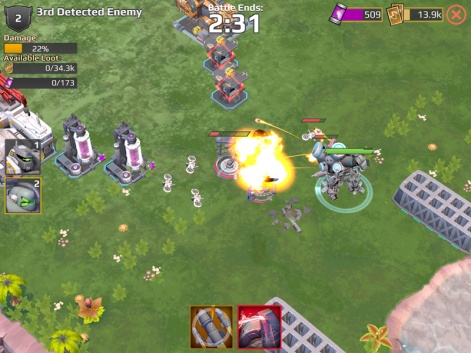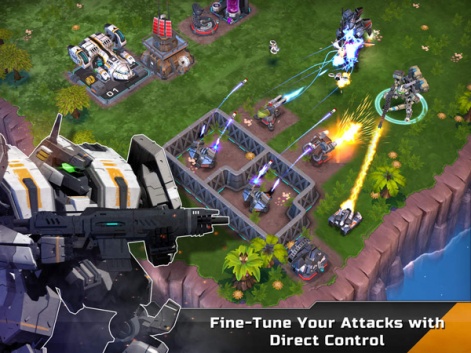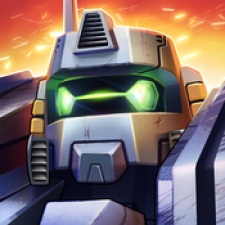It's often said in the world of free-to-play development that launching a game is the beginning, not the end.
These aren't boxed products released onto shop shelves, never to be worked on again. These are games-as-a-service that require constant operation and updating, often over a period of several years.
PocketGamer.biz has long been investigating the Making Of notable games soon after their launch, but what happens long after a game is released?
In an attempt to find out, this regular feature will talk to the developers behind maturing live games about their experience so far. You can read all our other entries here.
For this first entry, we chat to former Superweapon President - now Kabam Executive Producer - Amer Ajami about mech-based strategy game Dawn of Steel following the recent first anniversary of its launch.
PocketGamer.biz: With Dawn of Steel fast approaching its first birthday, how do you reflect on its performance - from launch to the mature title it is now?
I have mixed emotions about Dawn of Steel’s launch and Superweapon as a whole.
On the one hand, we started an indie dev studio during an environment of rapid consolidation and we created an amazing game with what often felt like half the required development staff.
We successfully launched it across four platforms in nearly a dozen languages worldwide (the game recently passed six million installs), and because of all that, the team in LA was eventually acquired by one of the industry's leaders.
We launched across four platforms and recently passed six million installs.Amer Ajami
By most measures, that’s a successful endeavour through and through.
But was the game that we eventually released the same one that we intended to from the beginning? Yes and no.
The spirit of the game that is live today is certainly still intact from the one we envisioned for it a few years ago.
But I think we soft-launched the game too early, and that forced us into a reactionary mode of development where we were responding to metrics that were being generated by immature or incomplete mechanics and interactions with the game.
That prevented us from being able to fully realise the game that Dawn of Steel needed to be for a number of critical months.
And likewise, we probably launched worldwide a bit too soon as well, having not released any social features until a few months after we got our major install spike.
So while I’m proud of the work that we did and the relative success that the game has achieved, it’s hard not to linger on what could have been with a few key differences in our development strategy.
How big is the team currently handling live ops on Dawn of Steel? Does it remain a going concern within Superweapon, or is this all now handled by publisher flaregames?
Flaregames continues to manage the live ops of the game, as they have since late Q2 or so.
As to how big that team is, I can’t say, but some of the developers at Flare who are still on the project today are the same ones who were on it from the first day that we signed our publishing deal with them back in 2014.

As someone who still cares about the game’s health, it’s nice to see that continuity.
How important do you consider customer support to be? What's been the approach to game updates?
To say that it’s important would be a gross understatement. In many ways, customer support and live ops are the game.
In many ways, customer support and live ops are the game.Amer Ajami
In addition to the standard stuff like bug fixes, content releases, economy tweaks, and feature rollouts, audiences expect their games to feel alive and constantly evolving.
Games today are more akin to television networks, where show producers are constantly planning and releasing a slate of updated and new content.
It wasn’t easy for a team of our size to keep up with the expectations of our audience while also continuing to do things like iterate on existing features.
But I’m proud that we were able to manage 14 client releases throughout soft launch and worldwide launch at a rate of about one every six weeks, not counting all the server-side updates we pushed out.
The game has now also been published in China by NetEase. What changes have been made for the Chinese market and have you been pleased with its performance there?
I believe the game is still in soft launch in China, but I think its real release date is rapidly approaching, if it hasn’t already happened.
As to what design changes were made specifically to appeal to the Chinese market, I really can’t say, as that would have been work done after Flare had taken over all of the game’s live operations.
Before that happened, however, we did localise the game.
We changed the game’s network architecture to allow the game’s servers in the rest of the world to communicate across the Great Firewall, and made it easier to integrate a wide variety of SDKs for things like install attribution to account for the fragmented platform structure of the Chinese market.
The most significant development relating to Superweapon in the past 12 months has been the fact that you're now part of the Kabam family. What impact has this had on Dawn of Steel, and your working environment in general?
That’s right. The Superweapon team in Los Angeles was acquired by Kabam in April of this year, around six months after the game’s launch, and the acquisition has had a fairly profound impact on both us as a group and our ability to support the game.
As a legal entity, Superweapon ceased to exist a few months after the acquisition.
Most of the Superweapon guys are now working on Kabam's Avatar game.Amer Ajami
Notably, we worked out a deal with Flare to take over development and support of Dawn of Steel, liquidated all of our company assets, vacated our studio space, and embedded ourselves with Kabam’s existing studio in LA.
Most of the Superweapon guys are now working on Kabam's recently announced Avatar game (it’s interesting to note that the setting for Dawn of Steel, Leviathan, was originally influenced by Avatar’s Pandora), whereas a couple of us are working on an unannounced game, which I’m leading development on.
So as far as Dawn of Steel is concerned, a few of us continued to support it for a couple of months after the acquisition as part of the handover to Flare, but since then, we haven’t been involved in any part of its ongoing development.
As for our working environment, it’s obviously very different now. We’re part of a larger group of talented developers at Kabam LA, and that has a different feel to the small indie studio we were previously running.
But in many ways, this acquisition represents a homecoming for us, as we all worked with many of the Kabam team members when we were all at Zynga and EA years earlier.
Dawn of Steel was your first game as Superweapon, so what have you learned from it? Is there anything about the game's development that, in hindsight, you'd now do differently?
The list of what I’d do differently if I could is longer than the ocean is wide! But if I had to pick a couple of the biggest lessons, they’d be:
- Don’t underestimate the financial implications of user acquisition.
When we started thinking about forming Superweapon in late 2012, the market conditions were very different than they were by the time we finally launched Dawn of Steel in 2015.
User acquisition costs were a couple of bucks, and the top ten lists in the App Store were still somewhat fluid.

When our game finally was ready for release, UA costs were somewhere between $8 and $12, and at times it felt like if you didn’t have a game in the top 10 in 2013 or 2014, then forget about cracking that list in 2015.
We really lucked out by having a constant stream of featuring on the App Store. We were bullish about supporting the latest iOS features - ReplayKit specifically - and I guess the Apple gods smiled down on us because of it.
Without that, our UA strategy would have come up woefully short.
- Don’t launch the game until you’re certain it’s ready.
As I alluded to above, we rushed to get it out the door, and that led us down the path of trying to iterate on existing features that weren’t mature, build out new features and content that we knew we’d need very soon, and react to player behavior and technical issues with the game.
It would have been better for us to have the uncomfortable conversation within our team about the game’s readiness and extend our launch date than to have pushed it out too early.
There are many others, but thankfully, these are two lessons that we’ve taken to heart, especially now that we’re at Kabam.
As innovative as Dawn of Steel was, I was deathly afraid of straying too far from the Clash of Clans formula.Amer Ajami
A company the size of Kabam obviously has a lot of resources at its disposal for marketing its games, and it knows the perils of launching games before they’re ready all too well.
Finally, how has your experience developing Dawn of Steel informed where you are/what you're working on now?
This ties into the previous question, but one of the lessons I’ve carried with me is not being afraid to innovate.
As innovative as Dawn of Steel was, I was deathly afraid of straying too far from the Clash of Clans formula.
And while I think there’s a lot of benefit to not reinventing the wheel at every opportunity, I think I stunted the potential of the game by placing undue pressure on our creative director to colour within the lines of existing (and ageing) designs instead of trying to come up with new mechanics that would differentiate us from others.
There’s no use trying to carve your own niche while also doggedly aping existing games.
While I can’t talk about what we’re working on at Kabam, I can confidently say that we’re pushing the boundaries of what people have come to expect out of a mobile game.
The level of talent that we have now is unbelievable, and the creative leadership at the company constantly challenges its teams to find new and interesting ways to innovate on the designs of its portfolio in ways that make sense.
Can’t wait to show you what we’re working on!





















